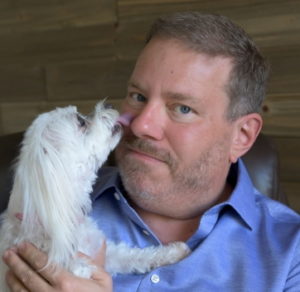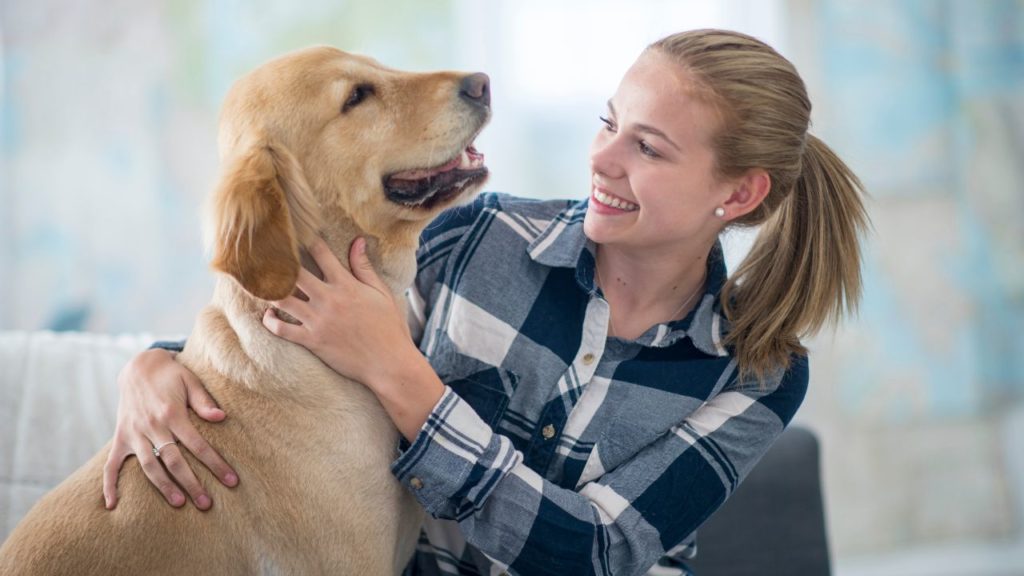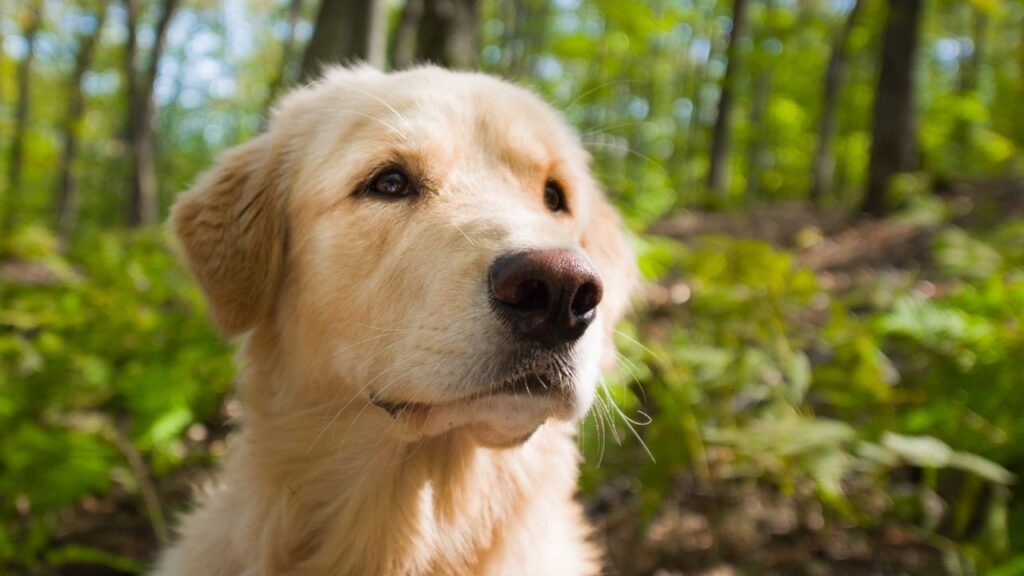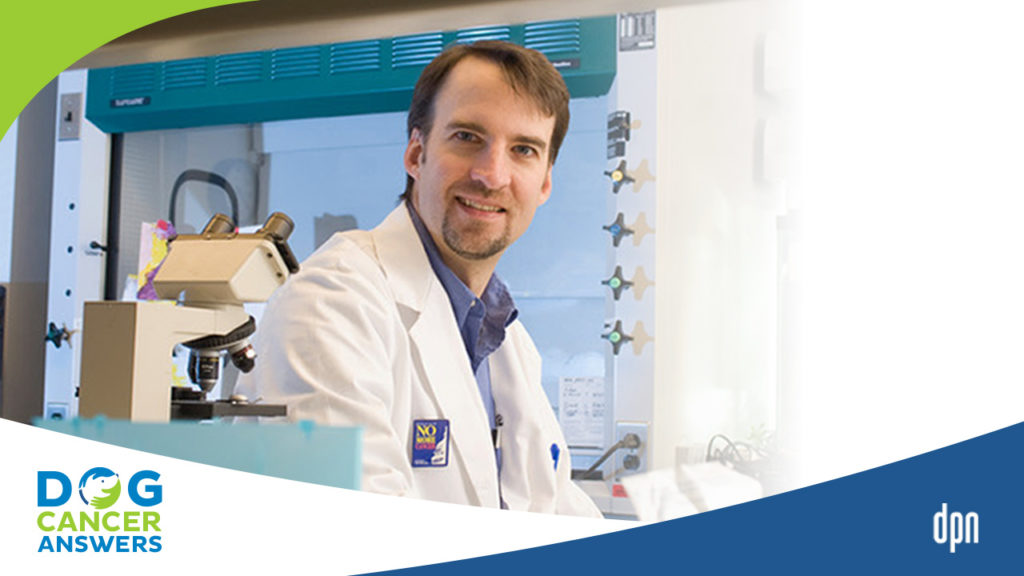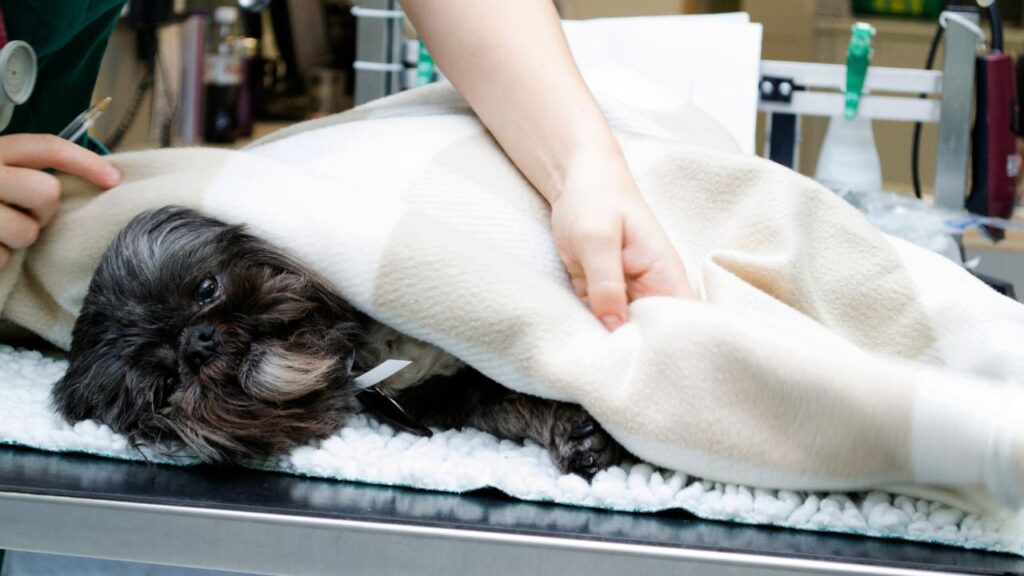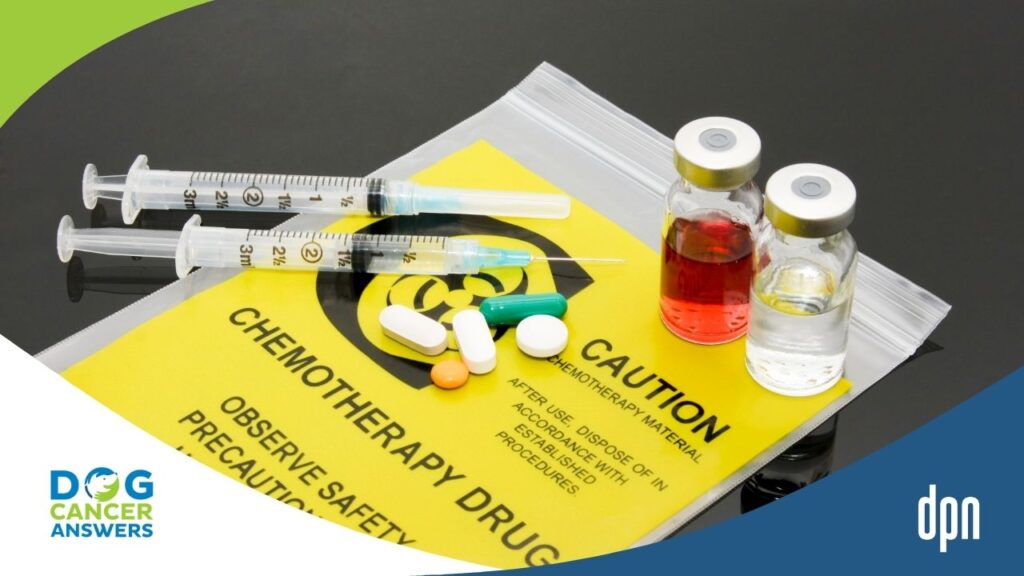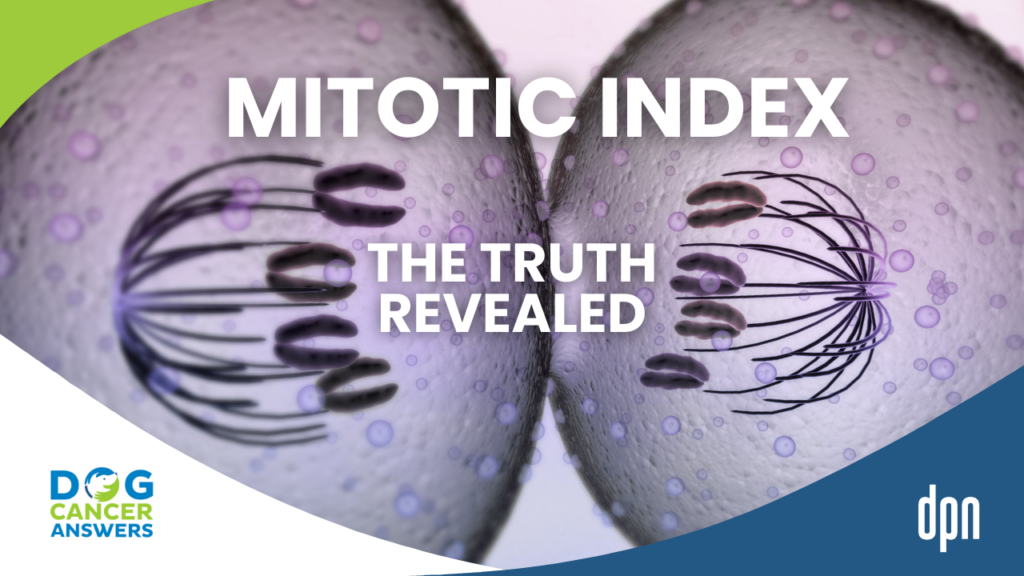EPISODE 163 | RELEASED April 18, 2022
Bone Marrow Transplants for Dogs | Dr. Steven Suter
Can lymphoma really be cured? This intense treatment is not the right fit for every dog, but can have a happy ending.
SHOW NOTES
Bone marrow transplants, also called total body radiation, are a fairly common procedure in human cancer treatment. Dogs can benefit from this procedure too! And the results are thrilling – about 30% of treated dogs are considered completely cured.
Dr. Steven Suter, the leading expert on bone marrow transplants in dogs, explains everything that goes into this procedure – and we mean everything. There are many steps and processes that have to be completed both to make sure that your dog is a good candidate for a bone marrow transplant and then to complete the transplant itself.
In this episode you will learn what needs to happen before a bone marrow transplant – from chemotherapy to achieve remission to finding a donor match – as well as the process and aftercare for the procedure. Bone marrow transplants are not the right fit for every dog or family, but this is a fascinating option to have available.
Links Mentioned in Today’s Show:
[00:00:00] >> Dr. Steven Suter: The whole reason I started doing this was not to do something crazy. It was because I’ve watched hundreds of dogs with lymphoma die being treated with our standard therapies, which is a CHOP chemotherapy. And it just became so frustrating to watch this happen over and over and over and over again, no matter what.
[00:00:19] >> Announcer: Welcome to Dog Cancer Answers, where we help you help your dog with cancer. Here’s your host, James Jacobson.
[00:00:27] >> James Jacobson: Hello friend, and welcome to Dog Cancer Answers. On this show, we talk about all sorts of ways of treating dogs with cancer, from chemotherapy to radiation, to Chinese medicine, to nutraceuticals. Today, we are talking about a type of radiation – that is full body radiation.
It is used to treat certain types of lymphoma and, um, it’s an aggressive type of treatment that is not right for everyone. One of the effects of the full body radiation is that it kills off all the dog’s bone marrow, but what’s cool about this is they have figured out a way around that. And that is why this procedure is called bone marrow transplant.
There are only a couple of facilities in the United States – or in the world – that do it, both here in the United States, and we are speaking today with the world’s leading expert on this. His name is Dr. Steven Suter, he joins us from North Carolina State University. Dr. Suter, thanks for being with us today.
[00:01:27] >> Dr. Steven Suter: My pleasure. Thanks for the invitation.
[00:01:30] >> James Jacobson: So you do something awfully interesting and something that a number of listeners to this podcast have looked at and had a lot of questions about, which is this bone marrow transplant. Can you, you know, provide us with an overview and then let’s get deeper into some of what it is and how it’s used.
[00:01:50] >> Dr. Steven Suter: Sure. Um, bone marrow transplant is used to treat animals with what are called hematologic malignancies. And so things like lymphoma and leukemia are the really big indications for – this treatment has been used to treat people with lymphoma and leukemia for many, many years. In fact, dogs were the model to develop the vast majority of the protocols that I use and that are used in people out at the Fred Hutchinson Cancer Research Center.
So it’s really me taking a wealth of data concerning dog transplants that’s actually been in the human literature, in a research setting, and moving it over into the clinical setting where we treat client-owned dogs instead of research dogs.
[00:02:32] >> James Jacobson: Okay. So before it was being used in humans, it was tested on dogs, and now it’s going back and effectively you’re using it on the primary animal that it was developed with.
[00:02:42] >> Dr. Steven Suter: That’s right. That’s a wonderful opportunity to give back to dogs the sacrifices that made, they made, during all the research trials that are still ongoing.
[00:02:52] >> James Jacobson: So let’s do an overview of what is involved in the process.
[00:02:55] >> Dr. Steven Suter: Sure. So the process is the use of stem cells, which are from the bone marrow, to repopulate the bone marrow after it’s been killed, for lack of a better word, from the radiation.
And so the only reason that a bone marrow transplant is needed is because radiation is used to try to kill every cancer cell in the body. In that process, the bone marrow, which is a very rapidly dividing cell tissue, which makes it very sensitive to radiation, essentially stops functioning. And so the radiation will be lethal, unless you can isolate the stem cells from the person or the dog ahead of time and then put them back in the dog after the radiation to allow the bone marrow to then expand and make all the cells that it needs to make for a dog to stay alive.
[00:03:40] >> James Jacobson: So the full body irradiation that happens – which you said would be lethal and it would basically kill all of the bone marrow – what does that process look like? How long does that take?
[00:03:51] >> Dr. Steven Suter: It’s pretty straightforward. So it’s called total body radiation. Radiation is used all the time to kill cancer cells, but usually in a local area. So if I had a tumor on my shoulder, let’s say, that the surgeons could not remove, radiation to that area would hopefully kill the remaining cancer cells left behind. In total body radiation, the dose is much lower and of course the whole body is included in the radiation field and that radiation is administered.
And when your animal and person is kind of away from the machine so that they can get a big cone of radiation, quite frankly, that they stand in or a dog lays in. The procedure takes about two hours two days in a row, because the dose is very low and in order to enable the- kill the cancer cells, for many reasons that I’m not going to go into.
So the actual processes in dogs is quite easy. They’re asleep only to keep them still, the radiation machine is turned on, they sit there, and then when they’re done, they’re done. We come back and do it the next day also. So it’s fairly straightforward.
[00:04:50] >> James Jacobson: Okay. And then describe what that’s like. You said that, you know, the people move out and basically a dog is sedated and then it’s exposed to the radiation for a couple hours, two days in a row.
[00:04:59] >> Dr. Steven Suter: Yeah. So not a couple hours. Uh, the radiation is administered via a machine called a linear accelerator. Those in the know, call it a LINAC.
[00:05:06] >> James Jacobson: A LINAC. I like that.
[00:05:08] >> Dr. Steven Suter: The LINAC. And so the LINAC is actually in a lead lined vault uh, because obviously the radiation can get out and could hurt people. So it’s basically, we call it the vault, and the vault has a big machine called a LINAC in it. And that’s where the radiation of all our patients occur. Most radiations, as I said, for dogs post-surgery the radiation is actually very quick, just a couple of minutes, but in the TBR, total body radiation dogs, because it’s so low dose, it can take an hour or so to get that whole dose into the dogs. So it’s in this room with a big lead door and nobody can go in, obviously, when the radiation is on. So that’s why the dogs are asleep and monitored via a camera.
[00:05:44] >> James Jacobson: Okay. And then after the two procedures – and do they normally happen in concurrent days?
[00:05:50] >> Dr. Steven Suter: Yep. Concurrent days.
[00:05:52] >> James Jacobson: Okay. And then what happens next after those two days?
[00:05:56] >> Dr. Steven Suter: Well, let me back up a little bit. Before the radiation, uh, we harvest the stem cells from the dog. And so they go through a particular procedure, they receive this, uh, medicine under their skin called Neupogen, which is in use in people who are receiving chemotherapy to keep your white blood cell counts up. So these dogs receive Neupogen for five days under their skin. We harvest their stem cells using this machine called an apheresis machine.
And then they go to radiation, radiation for two days to hopefully kill all the cancer cells in their body. Then we take those cells that we harvested from the dog before the radiation – which were just sitting in the refrigerator – we take them out and we give them back to the dog.
[00:06:36] >> James Jacobson: Do you give those blood cells back to the dog right after the second radiation treatment, or how long, what’s the intervening time?
[00:06:43] >> Dr. Steven Suter: Yeah, we give it right afterwards. So usually after the radiation done, we’ll, we’ll go into the vault and it’s an intravenous infusion so we’ll just hook, hang the bag and start giving the dogs the cells right away.
[00:06:53] >> James Jacobson: Okay. And then the drug that was used for five days prior, does that, I presume, stimulate the bone marrow, to increase the production?
[00:07:01] >> Dr. Steven Suter: Yeah, it’s really an amazing drug. It’s called Neupogen and it’s used in people all the time for when they receive chemotherapy to keep their white blood cell counts from going too low. And it also has another fantastic property in that it drives stem cells out of the bone marrow into the peripheral blood.
So peripheral blood always has some very low number of stem cells. Neupogen actually drives them out into the peripheral blood. And then we use that apheresis machine to collect those stem cells from the blood. And so it’s a, kind of a magic drug, you can do a bone marrow transplant and never touch the bone marrow, which is quite nice.
[00:07:39] >> James Jacobson: Yeah. Okay. And then you refrigerate the bone marrow until you can reintroduce the fresh bone marrow that had been harvested earlier through this machine that is then, I guess, replacing the bone marrow that’s been killed through the radiation.
[00:07:53] >> Dr. Steven Suter: That’s right. It just, it just basically replaces and it takes usually four to seven days, somewhere in that range, for those bone marrow stem cells that we put in a vein to go to the dog’s bone marrow and they get all happy in there and say, okay, we’re back home. And then they start making all the cells that an animal needs to stay alive. It’s pretty cool.
[00:08:12] >> James Jacobson: This whole process is fascinating and kind of like when you start looking at what is involved, it sounds, it sounds a little scary.
[00:08:20] >> Dr. Steven Suter: Yeah.
[00:08:20] >> James Jacobson: I know that a lot of people who have looked at this thought, Hmm, that’s a lot to go through. How many times have you done this?
[00:08:26] >> Dr. Steven Suter: We’ve transplanted 113 dogs so far.
[00:08:29] >> James Jacobson: Okay. And the average cost to do it is?
[00:08:32] >> Dr. Steven Suter: The cost has gone up instead of down, unfortunately. When I started this-
[00:08:36] >> James Jacobson: Inflation.
[00:08:37] >> Dr. Steven Suter: -I wanted to, um, try to do it enough that we could start getting cost down, of course, that hasn’t happened. So there’s two types of bone marrow transplants that maybe we can get into later, but the current price for an autologous transplant where we use a dog’s own stem cells is anywhere from $21,000 to $26,000. Most dogs come in around $22,000 to $24,000. So it’s a lot of money.
[00:08:59] >> James Jacobson: And obviously it’s really only done at your facility in North Carolina.
[00:09:03] >> Dr. Steven Suter: That’s actually incorrect. So it had been done at four different facilities. So our facility, there’s a, believe it or not, a private practice in Bellingham, Washington who started this because they’re sort of down the street from the Fred Hutchinson Cancer Research Center where all this research happens. So Bellingham still does bone marrow transplants on the west coast. And there were two other private practices in the United States, one in Los Angeles and one in Columbus, Ohio who did them, who are now have stopped for various reasons. So right now it’s just me on the, on the east coast and, uh, Dr. Ed Sullivan, who’s at Bellingham on the west coast. We got the coasts covered.
[00:09:39] >> James Jacobson: So when you go to these oncology conferences, it’s just the two of you guys sitting at the bar talking, talking shop.
[00:09:45] >> Dr. Steven Suter: That’s right. We’re the, we’re the um, the rogue transplanters, I guess.
[00:09:50] >> James Jacobson: So let’s go back to the process because there’s, it just engenders so many questions. So the dogs have had the radiation for two days, they’ve been re-introduced to the bone marrow, but they’re also in isolation for a while, right?
[00:10:02] >> Dr. Steven Suter: That’s correct, because it takes a while for their bone marrow cells, the stem cells that we give them, to kind of kick in, for a lack of a better word.
And so not only are, they’re on this drug Neupogen before the radiation and the stem cell harvest, which makes their white blood cell count go way high. So we stop that and then their whole body’s radiated. So their white blood cell count goes, boom. It just drops. And within two to three days, it’ll go to absolute zero, which strikes fear in the hearts of everybody who doesn’t deal with bone marrow transplantation.
We’re quite used to it by now. So their white blood cell count – and platelets – usually go to absolute zero, which again is something that just, you know, folks in general, aren’t used to. Veterinarians are not used to that. And so when their neutrophil count, which are the cells that fight infection, go to below a thousand or so, ’cause we know they’re going to drop to zero, then they go into an isolation ward until those cells shoot back up again, which usually takes two to four days.
So they do spend about, usually about four days in isolation.
[00:11:08] >> James Jacobson: So, are they in total isolation or are they’re being attended to, or – describe this isolation?
[00:11:14] >> Dr. Steven Suter: Yeah, they are attended to, of course. So here at NC State, we have these beautiful, positive pressure, HEPA filtered isolation wards with basically wall to ceiling glass. And there’s a little foyer in between two of them. And we go in and put on our gowns and our head gowns and personal protection gear, obviously, and go in and tend to the animals, and then obviously come back out. So they’re actually attended to quite often.
[00:11:38] >> James Jacobson: Okay. But it’s not like the pet parents can come visit during that time because they’re in isolation.
[00:11:44] >> Dr. Steven Suter: That’s right. The, really, the main point of the isolation is to keep them isolated from other animals in the hospital because the hospital’s full of sick animals.
[00:11:51] >> James Jacobson: Okay. And basically they have no immunity at that point because all of that has been destroyed through the radiation.
[00:11:56] >> Dr. Steven Suter: Yep. That’s right.
[00:11:57] >> James Jacobson: What are some of the other, unwanted, I guess, side effects of the full body radiation?
[00:12:02] >> Dr. Steven Suter: So radiation is very similar to chemotherapy. It tends to be very active against rapidly dividing cells. And so that’s why the bone marrow is so affected by radiation because it’s a very rapidly dividing cells. We need to make about 2 trillion cells a day to stay alive. So that’s-
[00:12:18] >> James Jacobson: Two trillion cells a day, okay.
[00:12:19] >> Dr. Steven Suter: A day. And for your entire life.
So that’s why that’s my favorite tissue in the body. It’s quite remarkable that it can do that without a brain. So it’s pretty cool. The gut is also a rapidly dividing tissue, and that’s why people who receive chemotherapy can become very ill because chemotherapy can really affect the cells of the gut, which have a very rapid turnover.
And that’s the same in dogs so radiation, if we see side effects besides the obvious bone marrow issues, it’s gastrointestinal issues. So vomiting, diarrhea, lack of appetite, things like that.
[00:12:53] >> James Jacobson: What about hair and fur?, I mean, you know, oftentimes when a human being gets radiation, they go bald, does that effect, or do you get burns and that type of thing with full body radiation or no?
[00:13:04] >> Dr. Steven Suter: Yeah, they, the, all the dogs that need groomed – and this is the same for chemotherapy – Poodles, Bichon, Shih Tzus, they lose their hair. Goldendoodles lose their hair. Same with chemotherapy.
[00:13:14] >> James Jacobson: All the way?
[00:13:15] >> Dr. Steven Suter: Yep.
[00:13:15] >> James Jacobson: Wow. Okay.
[00:13:16] >> Dr. Steven Suter: Lose it all. They look like, um, pretty funny, big rats for a while, but it all grows back, usually within two months or so it all grows back. Dogs who don’t have that constantly growing hair that need groom, they don’t lose their hair. Their fur, sorry. I always call it hair, but it’s fur.
[00:13:31] >> James Jacobson: Okay. The specific types of cancers that this is mainly used with are a few. Two?
[00:13:39] >> Dr. Steven Suter: Yeah. The main one is lymphoma, which is very similar biologically to non-Hodgkin’s lymphoma in people.
And so dogs get both B and T-cell lymphoma. T as a general rule is a worse disease. Those dogs tend not to do that well with chemotherapy when compared to B-cell lymphoma. So we treat mainly dogs with B and T cell lymphoma with this type of transplant called an autologous transplant, or the easier way to say it is an auto transplant. That’s where we use the dog’s own stem cells.
[00:14:11] >> James Jacobson: Got it.
[00:14:11] >> Dr. Steven Suter: You can also treat dogs who have leukemia, so acute leukemias can also be treated. We have treated some dogs with acute leukemia. The problem with acute leukemia is you need to find a donor dog who does not have cancer because you can’t get a cancer-free graft from a dog with leukemia, because leukemia is defined as having cancer cells in the body.
And no matter how much chemotherapy you give a dog, they always have a lot of cancer cells floating in their body when they have an acute leukemia. So you can’t really use a dog’s own stem cells. We could, but we can’t harvest them without having a lot of cancer cells too, since we harvest the stem cells from the blood.
[00:14:49] >> James Jacobson: And you’re reintroducing the cancer. Yeah.
[00:14:50] >> Dr. Steven Suter: So we have to find a donor. Which we can. And we have.
[00:14:54] >> James Jacobson: Wow. So again, very much hearkens to human medicine.
[00:14:57] >> Dr. Steven Suter: Very similar.
[00:14:58] >> James Jacobson: But leukemia is not as common to use with this procedure as the lymphomas, as the B and T cell.
[00:15:05] >> Dr. Steven Suter: Yeah. And there’s two big reasons for that. One is leukemia in dogs, acute leukemia in dogs, is horribly aggressive. Horribly. It’s a terrible disease. I hate it. And, uh, those dogs tend to respond to chemotherapy quite well, but that response is very short. And so, you know, if I have an acute leukemia dog who, and he lives six months, it’s almost a miracle. You know, they usually live a couple months with treatment because it just becomes so resistant to chemotherapy.
And the reason that’s important is because the matching process can take a few months to get it done. The owners have to find related dogs. We have to get blood from those dogs. We send those, actually, those blood samples out to the Fred Hutchinson Cancer Research Center in Seattle for them to do the genotyping, that takes a couple weeks. So the whole process can take two to three months. And many of those dogs, unfortunately, don’t make it to transplant because of that.
[00:15:55] >> James Jacobson: And what kind of success rates do you see with it, with lymphoma?
[00:15:59] >> Dr. Steven Suter: So again it’s, sort of depends on the type. And so we can do both auto, using the dog’s own stem cells, or allogeneic, so an allotransplant, for dogs with lymphoma.
The success rate, or the cure rate of dogs with B-cell lymphoma using an auto transplant – so this gets a little complicated.
[00:16:20] >> James Jacobson: Right.
[00:16:20] >> Dr. Steven Suter: Dogs with B-cell lymphoma, being treated with an auto transplant, with their own cells, is somewhere between 30 and 40%.
[00:16:27] >> James Jacobson: Okay.
[00:16:28] >> Dr. Steven Suter: Which is much better than chemotherapy, which is essentially 0%.
[00:16:32] >> James Jacobson: And then define what success rate, what a cure means.
[00:16:37] >> Dr. Steven Suter: Sure. So a cure in dogs with lymphoma, post-transplant, if those dogs are alive two years post-transplant, they’re cured of their disease. Those dogs just don’t relapse at that time.
[00:16:48] >> James Jacobson: Okay.
[00:16:48] >> Dr. Steven Suter: And so that’s the, kind of the line we look for is for an animal to make it past two years, once past two years, they’re good to go.
[00:16:55] >> James Jacobson: Okay. So 30 to 40% are cured. They live two years beyond treatment.
[00:17:00] >> Dr. Steven Suter: And they live a normal life.
[00:17:01] >> James Jacobson: With the B-cell lymphoma using their own cell, their own, uh.
[00:17:05] >> Dr. Steven Suter: You’re getting it.
[00:17:06] >> James Jacobson: Okay. Okay. And then the T-cells, how successful is that?
[00:17:09] >> Dr. Steven Suter: Not as good. And so that’s exactly the same as chemotherapy with T-cell dogs. It doesn’t work as well. So the, there’s only one paper been published, which is mine in a small group of dogs, about 15. And that success rate was around 20%. So it’s almost half of the cure rate of what the dogs with B-cell lymphoma. And interestingly with chemotherapy, the overall survival for dogs with T-cell lymphoma is about half of what it is with B-cell lymphoma. So sort of mirroring the chemotherapy experience.
[00:17:38] >> James Jacobson: So why would you do this versus chemo if you have T-cells?
[00:17:42] >> Dr. Steven Suter: Um, well, actually it extends their lives longer. So the median survival of those transplant dogs who have T-cell lymphoma with an auto transplant is 602 days, um, which is way longer than, uh, chemotherapy alone, which is just around six months or so.
[00:17:57] >> James Jacobson: Okay.
[00:17:57] >> Dr. Steven Suter: Uh, but it is expensive. It’s an extremely difficult decision. I wish it was higher, you know, the percentage, but right now it’s not. However, if I may digress a little bit, that’s why we really push for an allotransplant using a donor stem cells for dogs with T-cell lymphoma especially because we’re pretty sure that cure rate at this point – small number of dogs – is 50% and that’s way better than 20%.
So that’s why we always try to get folks to find, uh, related dogs quickly so we could do an allotransplant for dogs with T, actually and B-cell. We like to try allo first because the cure rate’s about double.
[00:18:35] >> James Jacobson: And so in terms of that, finding that match, you want to find a litter mate, is that usually the best?
[00:18:39] >> Dr. Steven Suter: Yeah. So litter mates are the closest, the bitch and the sire are also good. All those dogs have a 25% chance of matching. It’s not cumulative. So if you find four dogs, that’s not a hundred percent chance. They’re all 25%. Folks can also look for dogs from the same mating pair. Uh, they’re also 25%. So the more dogs folks can locate, the higher the chances of finding a dog that matches.
[00:19:02] >> James Jacobson: Okay. Dr. Suter, I want to take a break, but when we come back, I want to talk about advice and thoughts you have for people who are considering this.
[00:19:09] >> Dr. Steven Suter: Sure.
[00:19:10] >> James Jacobson: Stick around. We’ll be right back.
We are back. During the break, we were chatting a little bit and our producer said, "I hope I never have a dog who needs this." And you said, "Me too. I hope you never have to do it." Is this something that you would do with your own dog, Doctor?
[00:19:27] >> Dr. Steven Suter: Yeah, I really would. I’m obviously horribly biased because I’ve been doing this for almost 10, 10, 11 years now, but the whole reason I started doing this was not to do something crazy, it was because I’ve watched hundreds of dogs with lymphoma die, uh, being treated with our standard therapies, which is a CHOP chemotherapy. And it just became so frustrating to watch this happen over and over and over and over again, no matter what. The cure rate with chemotherapy alone is terrible.
It’s less than 5% at best. And so, you know, based on my PhD experience, I learned about bone marrow transplant, and I quickly wanted to try to do something that would help our animals after watching so many of them pass away from lymphoma and leukemia.
[00:20:09] >> James Jacobson: And that’s right. When I looked at your bio, your interest in this predates your going into veterinary medicine, is that true?
[00:20:17] >> Dr. Steven Suter: Yeah, uh, sort of accidentally, and many things I’ve done have been sort of by accident actually. When I started doing my PhD when I was at Penn, I was in a dual degree program there that was a vet degree and a PhD. And I actually ended up becoming very interested in bone marrow transplantation because I was using that to treat a type of immunodeficiency called severe combined immunodeficiency. As a model for the human disease, there were two dog models there. And we were using bone marrow transplantation and gene therapy, which is part of my PhD, to try to treat that disease and make it go away, which actually works. And so I ended up doing a lot of bone marrow transplants during my PhD, and that’s how I really learned about all the information that’s out there in the research setting, as far as transplanting dogs and the use of dogs as a model.
So it was a really, it just opened my eyes to the possibilities. And then I became an oncologist, I did a residency in oncology, and it just sort of almost accidentally all fit together into this idea that this can be done. And, um, based on Dr. Sullivan’s one publication in 2006, showing that it can be done in a clinical setting by a GP in a private practice, that was it. I knew it could be done in a university setting.
[00:21:30] >> James Jacobson: And you are pretty much the world’s leading expert on this at this point.
[00:21:35] >> Dr. Steven Suter: Sadly, that is true.
[00:21:36] >> James Jacobson: As I said, it’s just the two of you guys at a bar at some vet conference.
[00:21:39] >> Dr. Steven Suter: That’s about it. Yeah, I know. And sadly, there’s nobody else doing it. And I’ve had a bone marrow transplant fellowship for years now for veterinarians who can come and learn these techniques with the hopes that they would go out and spread the word and start doing this. I mean, I can treat, you know, 20 dogs a year. We see tens of thousands of cases of lymphoma every year across the United States. And so my hope has always been to spread the information and to get people trained up in it so they can go out and start doing this at other universities or, or practices.
And it really hasn’t happened, unfortunately, quite yet.
[00:22:14] >> James Jacobson: Why do you suppose that is?
[00:22:16] >> Dr. Steven Suter: Well, I don’t know, to be honest with you. I think that the veterinary medical oncology community is quite skeptical, which of course we all should be, because we don’t want to harm animals. As I was talking to Kate earlier, there’s a lot of misinformation about it relating to efficacy and/or toxicities, a lot, quite frankly.
And it’s also not easy to get set up and to actually do it. There’s a lot of infrastructure that is, I had to build to do this, so that can be difficult also. There’s clearly people who want their dogs to go through this procedure. We have a waiting list of 16 dogs, 16 families and their dogs, all the time, which is frustrating because we can’t get to them all the time. So there’s clearly a need.
[00:22:55] >> James Jacobson: And these are dogs that really, I mean, can’t necessarily wait so long because they have advanced cancer.
[00:23:01] >> Dr. Steven Suter: That’s correct. And so.
[00:23:03] >> James Jacobson: Yeah.
[00:23:03] >> Dr. Steven Suter: It’s multifactorial. Yeah. I have some veterinarians who send me cases all the time who believe it. And I have theirs who never do and don’t believe in it.
[00:23:12] >> James Jacobson: So you said there some misconceptions or some myths, what are they?
[00:23:16] >> Dr. Steven Suter: Well, I’ve heard a lot, a lot of, it’s kind of a long list. One is that the dogs end up in a black hole of an isolation ward for two weeks, which is not true. Uh, it’s too toxic and dogs die. We have lost some dogs, it’s not benign, that’s for sure, but we haven’t lost a dog since 2016. I think our protocol’s rock solid now. And so a lot of people feel that it’s not worth the risk. I’ve heard that the dogs are tortured because the total body radiation is horrible and they poop and puke and, you know, their guts out for three weeks, which they don’t. So things like that related to toxicity and efficacy.
[00:23:52] >> James Jacobson: Okay. But I mean, they have some reactions.
[00:23:54] >> Dr. Steven Suter: Of course.
[00:23:55] >> James Jacobson: Not three weeks of pooping, but some of those things may be embellished, but they’re factual. No?
[00:24:01] >> Dr. Steven Suter: They are. They definitely have GI side effects. Not bad, but they do.
[00:24:04] >> James Jacobson: Okay. And you say you haven’t lost a dog in the process since 2016, so that’s pretty good.
[00:24:10] >> Dr. Steven Suter: That is pretty good. And you know, I, wasn’t an expert on bone marrow transplantation when I started this. I learned, we learned as we’ve gone along. And when I first started the program, I sort of transplanted any dog that walked through my doors because I was trying to show that we have ability to do it and to show my dean that there was a client base that were willing to come to us to have this done.
So we did lose some dogs. And early on, I look retrospectively, I think, well, you know, maybe we shouldn’t have done that transplant. But people forget to realize that dogs with lymphoma have a lethal disease. They have a 98% chance of dying from that disease relatively soon, within a year or so. And so, you know, somebody has to do something.
[00:24:53] >> James Jacobson: Yeah. So what are the considerations, if you’ve decided that you want to do this, what are some of the things that a dog lover should take into consideration?
[00:25:03] >> Dr. Steven Suter: Well, I think the first thing is to call us so we can talk to them. We don’t enter into any transplant, no matter what type it is, with frivolity. You know, this is a big decision. The animals need to come to us or to the west coast. It’s a big trip. We transplant dogs from Canada, all over the United States, and internationally. One thing is information and we stress highly that we have a phone consult with the owners so they can understand exactly what we’re talking about, understand the pros and the cons – and there are pros and cons – to the procedure before they even attempt to make a decision. So that’s really important to us, is that everybody’s on the same page and we all understand what the issues are. Number two, obviously, is the money. It took me five years to convince VIP Pet Insurance that this is not experimental, it’s actually clinical service, which it is. And so now insurance covers this procedure. They also cover the matching if folks want to find a donor. So that’s huge.
[00:25:59] >> James Jacobson: So is that all insurance firms or just-?
[00:26:01] >> Dr. Steven Suter: Uh, VIP, Nationwide, Pet Partners, and a couple of others do. And so that’s obviously a tremendous help. So that’s the first thing I say to folks, you have pet insurance? Because they cover 80 to 90%, which is fantastic.
The other issue is really, you know, life is complicated. People have children, jobs, when they have to figure out a way to get at least their dog here, and if it’s an allotransplant, get the donor dog here also, and that can involve expense and time, et cetera, et cetera. So those are all issues that make this decision extremely difficult and we don’t take it lightly at all.
It’s really important that at least they have all of the information that I can tell them about everything before they make that decision. So we always insist on a phone consult of these, and those take usually an hour to an hour and a half. And many times we’ll talk to people multiple times as they’re trying to go through this process.
[00:26:50] >> James Jacobson: So a lot of these dogs obviously, probably already have local oncologists, if not general practice vets. Do you find some of your time spent communicating to them the benefits of the process?
[00:27:02] >> Dr. Steven Suter: We always communicate with a local treating veterinarian. Most are oncologists, but some of them aren’t. All dogs are on chemotherapy before they come to see us so we like to modify the protocol for certain reasons. So we work with them very closely also.
[00:27:15] >> James Jacobson: And then in terms of the breeds of the dogs, obviously we know what kinds of cancer, but like, is it better for bigger dogs, or smaller dogs, or certain breeds?
[00:27:24] >> Dr. Steven Suter: Lymphoma used to be sort of known with, uh, breeds like bully breeds, so English Bulldogs and those types of dogs with really short noses. But all the popular breeds now, unfortunately, are packed with cancer and lymphoma’s probably number one. And so pick a popular breed, you know, Labs, Goldens, Boxers, et cetera, et cetera. Those dogs are all the dogs that are really loaded with lymphoma.
Now, I’ve been doing this for close to 20 years now, we see lymphoma across almost all breeds. And clearly we don’t see a lot of Jack Russell Terriers, but we’d see some Jack Russell Terriers. So we see it among small dogs, breeds, now where it usually it was a middle to large sized dog breed. So.
[00:28:02] >> James Jacobson: Is there any dog that’s too small to undergo this process?
[00:28:06] >> Dr. Steven Suter: That’s interesting. So, uh, we, we used to have sort of a size limit on dogs of 20 kilograms, and we’ve gotten better and better with this machine that we have, and so I dropped the size to 15 and to 10. We’re actually looking at a, getting ready to do a five kilogram Yorkie, Yorkshire Terrier, which is really little, it’s going to be very technically challenging, because the machine is made for people.
So I would say, you know, five kilograms or less, that’d be technically challenging to do it, but we don’t really have any real size limit at this point. The other thing I should mention about the breeds is that in the old days, back when I was in veterinary school, you know, lymphoma was a disease of middle aged to older age dogs, and it still sort of is. And so if you have a dog with lymphoma, and it develops it at 10 and they live two years on chemotherapy and it’s, you know, it’s a big Golden Retriever, that’s actually, actually not too bad. But unfortunately the demographics of the disease has changed dramatically over my career as a veterinarian.
So the average age of the dogs that I transplant is four. And so that’s what makes families really think that maybe transplant’s an option and they have a beautiful Golden Retriever who’s three years old and they have children that they want to grow up, you know, grow up with that dog. And that dog just is not going to see five, period, with chemotherapy.
So the average age of our dogs is four. We’ve transplanted dogs that are two. I see dogs with lymphoma that are one year old. And so it’s really the young dogs whose families are really kind of interested in this procedure.
[00:29:31] >> James Jacobson: Well, Dr. Steven Suter, thank you so much for being with us. I know that over the years a number of people have been interested in this and I was just so delighted to have you come on and explain this process ’cause it is a little foreboding from the outside.
[00:29:45] >> Dr. Steven Suter: It is. It is.
[00:29:46] >> James Jacobson: And you are the eminent leader in this.
[00:29:49] >> Dr. Steven Suter: That is true. I don’t know how it happened, but I am.
[00:29:52] >> James Jacobson: Someone’s got to do it. Thank you so much for being with us on Dog Cancer Answers.
[00:29:56] >> Dr. Steven Suter: Thanks so much for having me. Most appreciated.
[00:29:58] >> James Jacobson: And I would like to thank you for joining us today on this very special episode of Dog Cancer Answers. We don’t often delve into radiation ’cause it’s not that commonly used, and this is a very aggressive procedure, and it may not be right for everyone, but if it is something that you are interested in, now you have some more information and you should get in touch with them. I hope you will continue to listen to Dog Cancer Answers because we have other episodes about all sorts of things and you can find our entire back catalog on our website at DogCancerAnswers.com.
Please, if you enjoyed this episode, do us a favor and tell a friend, or your veterinarian, or maybe your vet is your friend, about Dog Cancer Answers. I’m James Jacobson, on behalf of all of us here at Dog Podcast Network, I want to wish you and your dog a very warm, Aloha.
[00:31:02] >> Announcer: Thank you for listening to Dog Cancer Answers. If you’d like to connect, please visit our website at DogCancerAnswers.com or call our Listener Line at (808) 868-3200. And here’s a friendly reminder that you probably already know: this podcast is provided for informational and educational purposes only.
It’s not meant to take the place of the advice you receive from your dog’s veterinarian. Only veterinarians who examine your dog can give you veterinary advice or diagnose your dog’s medical condition. Your reliance on the information you hear on this podcast is solely at your own risk. If your dog has a specific health problem, contact your veterinarian.
Also, please keep in mind that veterinary information can change rapidly, therefore, some information may be out of date. Dog Cancer Answers is a presentation of Maui Media in association with Dog Podcast Network.
Hosted By
SUBSCRIBE ON YOUR FAVORITE PLATFORM
Topics
Editor's Picks
CATEGORY

